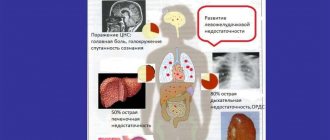To assess the condition of the body and, in particular, the performance of the immune system, a general blood test (CBC), or, as it is also called, a clinical test, is performed. The composition of blood is very complex and is represented by various shaped elements, and the protective function is assigned to white bodies - leukocytes.
They originate and mature in the red bone marrow, gradually passing through all stages of development, and only then enter the bloodstream. However, when a certain number of pathologies occur, young, not yet fully formed cells can be released into the bloodstream, which should be the reason for ordering additional examinations to look for the disease.
If, for example, according to the results of diagnostic measures, metamyelocytes are detected in the blood, then with a high degree of probability it can be argued that the quality of functioning of the immune system has decreased.
Normal indicators
Myelocytes are represented by large cells, and their nucleus can be oval or kidney-shaped with a small amount of protoplasm. It is characterized by a special structure, which depends on the alternation of darker and lighter areas of chromatin. As a result, a certain folding effect is achieved.
The norm of myelocytes in the blood suggests the absence of these cells. All cells are located in the bone marrow. In adults and children, the content of neutrophil cells ranges from 4.8 to 9.6%, eosinophilic cells - 0.6-2%, basophilic cells - 0.2-1%.
Deciphering a detailed blood test in children
During a detailed analysis, the qualitative and quantitative parameters of blood elements are taken into account. Capillary blood is usually used for research.
What does deciphering a detailed general blood test mean? In the red blood group, the quality, quantity of red blood cells and all their indices are assessed. The norm for almost all indicators depends on the sex of the baby, and in addition, as already noted, on age.
Each laboratory uses its own reference values, written in the norm column for a detailed blood test in children. They may differ between laboratories, but such differences will be insignificant. Normal indicators depend on the methods of counting blood elements, as well as the equipment used. The doctor must take this fact into account when deciphering the analysis. The standards are presented in the table.
The group of absolute indicators includes indicators of hemoglobin concentration, qualitative and quantitative characteristics of red blood cells. The pediatrician focuses on both indicators when deciphering a detailed general blood test and determining the diagnosis.
Hemoglobin is a protein that is responsible for binding oxygen molecules and transporting it to tissues, organs, and systems. This protein easily combines with oxygen and releases it just as easily. The transport characteristics of blood and, accordingly, the activity of the brain, heart, and the development of the child directly depend on the saturation of the blood with hemoglobin.
By about six months of age, gender differences in hemoglobin levels become noticeable:
- The normal hemoglobin concentration for girls 0.5-2 years old is considered to be 106-148 grams/liter. For boys of this age, the norm is as follows: 114-144 grams/liter.
- The normal hemoglobin level for girls 3-6 years old is considered to be 102-142 grams/liter. For boys of the same age, the norm is as follows: 140-140 grams/liter.
An increase in the concentration of hemoglobin in a general detailed blood test in a child is observed with pulmonary failure, cardiac dysfunction, pathological changes in the kidneys, diabetes, blood diseases, and dehydration.
Red blood cells are formed elements whose main task is to transport hemoglobin and interact with oxygen molecules. These elements are present in large quantities in the blood. Deviations from normal values are evidence of impaired regenerative function of red blood or too much loss of it.
When assessing the state of red blood, laboratory technicians take into account the number of red blood cells and their shape (normally they have a biconcave shape), as well as their level of maturity. No less important are the following indices: the average content of hemoglobin in an individual erythrocyte, the average erythrocyte volume (MCHC and MCH, respectively).
Reticulocytes are immature red blood cells. Sometimes laboratories count the absolute value of reticulocytes, but usually they analyze their percentage in relation to the total number of red blood cells. An increased reticulocyte count indicates accelerated breakdown of red blood cells.
A deficiency of erythrocytes is observed in leukemia and other oncological pathologies, hemolysis, genetic enzymopathies, large blood loss, and nutritional anemia. An excess of red blood cells may indicate fluid deficiency, active loss of fluid, serious pathology in the kidneys, heart, narrowing of the renal artery, erythremia.
Also, when deciphering the results of a detailed blood test, relative indicators are also taken into account. An important relative indicator is hematocrit, which allows one to assess the ratio of the number of formed elements to the total volume of plasma
That is, in fact, hematocrit reflects the thickness of the blood
An important relative indicator is hematocrit, which allows one to assess the ratio of the number of formed elements to the total volume of plasma. That is, in fact, hematocrit reflects the thickness of the blood.
Hematocrit can decrease with renal failure, anemia, and increase with dehydration due to extensive burns, vomiting, diarrhea, blood loss, and diabetes.
Normal indicators
Since leukocytes are formed in the bone marrow, it is not possible to find out the exact number of normal metamyelocytes. A greater concentration of young neutrophies in a general blood test is indicated by a shift in the leukocyte formula to the left. This indicates the presence of inflammation in the body, absolute leukocytosis, blood leukemia, etc.
To decipher a blood test, about 200 leukocyte cells are taken for counting. Next comes counting each population of the white blood sprout separately, including specific structures. In an adult and a child, the reference leukocytogram indicators are different.
Table of indicators of metamyelocytes in the leukocyte formula
How many metamyelocytes should there be normally?
In a person who does not have disorders of the immune system, metamyelocytes should not be present in the bloodstream. These are not yet mature, in other words, young bodies going through the last stage of development, that is, they are the precursors of neutrophils.
They are formed from myelocytes located in the bone marrow and are sometimes able to enter peripheral blood vessels only after they pass into the stage of band neutrophils. The latter will then form full-fledged segmented neutrophils.
The above means that the norm is when immature forms are not contained in the bloodstream. If, on the contrary, young leukocytes are detected during a blood test, then the reason for their appearance is almost always a lack of mature cells responsible for the protective function.
This state of the body is often characteristic of an infectious process, when during the destruction of the pathogen there is a massive death of leukocytes, and the bone marrow produces and releases immature formed elements into the blood.
For example, a slight increase in the percentage of young white blood cells in children with weakened immune systems and in pregnant women is considered acceptable. In addition, young patients often experience an increase in the level of immature white cells in a blood test due to an infectious disease such as rubella, chickenpox, influenza, etc.
To determine the indicator of metamyelitis, more than 200 white formed elements are counted in the laboratory. Then the percentage of each type of leukocyte is calculated. The detection of young blood cells in the studied material indicates difficulties in the maturation of cellular elements of the plasma.
This disorder is often observed during severe infection and is usually accompanied by an increase in the number of neutrophils. So, the permissible level of metamyelocyte content in newborn infants should not exceed 4%.
In babies from 1 to 4 days of life - 2.5%, in infants up to 2 months - 1.5%, and in all children older than this age, as well as adults, metamyelocytes are not normally detected during analysis. The only exception is women during pregnancy; in this condition, the indicated coefficient can range from 0 to 2%.
Reasons for the presence of myelocytes in the blood
Sore throat may be the cause of the presence of myelocytes in the blood
If, during a general blood test, myelocytes were detected in a child or adult, this indicates the presence of the following pathological processes:
- Bacterial infections of an acute nature, which are characterized by the addition of a purulent-inflammatory process. If the norm of myelocytes in the blood is disturbed, then the following pathologies can be diagnosed in a person: appendicitis, ENT infections, tonsillitis, acute pyelonephritis, pneumonia, tuberculosis, sepsis, cholera, scarlet fever.
- Necrotic processes are caused by diseases such as heart attack, stroke, gangrene, and large burns.
- Poisoning of the body with alcohol or lead, resulting in a negative effect on the bone marrow.
- Intoxication with pathogenic toxins, characterized by the absence of infection by the bacteria themselves. In this case, the norm of myelocytes in the blood will be disrupted if botulism toxin enters the human body. Then the breakdown of toxins has not occurred, and the bacteria themselves are dead.
- Malignant tumor with decay.
- The norm of myelocytes in the blood may be disrupted, even if at the time of taking a general blood test the person has completely cured the infectious disease.
- Severe illnesses. It will be possible to detect myelocytes in the blood of a person suffering from typhoid, paratyphoid, or brucellosis.
- Disrupted normal cell levels in the blood can be the result of severe viral diseases: measles, influenza, rubella.
- Side effect from taking medications. Most often this happens when taking immunosuppressants and painkillers. Therefore, before using them, you should carefully study the instructions.
- The normal level of myelocytes in the blood can be disrupted due to radiation exposure, radiation therapy and chemotherapy.
- Blood disease: leukemia, apathetic anemia, lack of B12 and folic acid.
Why is it dangerous?
The undeveloped cells themselves do not have a negative effect on the embryo.
However, when their high concentration is provoked by viral infections in a pregnant woman, the risk of harm to the unborn child remains. This will require urgent medical intervention aimed at identifying and subsequent treatment of the pathology.
The presence of unformed blood cells in excess of the norm in the complete absence of complaints indicates the development of hidden pathologies.
Reasons for detection
As noted above, in a normal blood test, metamyelocytes are not present in children and adults. If they are detected, this indicates that new cells are not maturing to their full-fledged state. As a result, it is difficult for the body to overcome the infectious disease on its own. This disorder is called leukemoid reaction.
The reasons for the appearance of metamyelocytes in the blood plasma of a child and an adult can be not only diseases:
- Extensive burn, depression, stress, psychological trauma.
- Heavy, fatty foods, poisoning, allergic reactions, taking various medications can also provoke disorders.
- Separately, it is worth noting physiological blood leukocytosis, which occurs episodically over a short period of time.
- Metamyelocytes can also be detected in a blood test in infectious diseases such as scarlet fever, diphtheria, typhus.
Depression can trigger the presence of metamyelocytes in a blood test
Treatment
Elimination of the cause leads to normalization of the blood picture
Since myelocythemia is caused by the development of a disease, it is the root cause that requires treatment.
Only after the cause of the pathological change in blood composition has been clarified, treatment is prescribed.
There are many reasons for the penetration of immature blood cells, in particular myelocytes. The vast majority of such triggers, unfortunately, are dangerous diseases that can quickly claim a human life. At the slightest transformation in the composition of the blood, it is necessary to urgently consult a doctor, diagnose and prescribe the necessary treatment methods.
source
How to cure the condition
Treatment of disturbances in the norm of myelocytes in the blood
If the norm of cells in the plasma is exceeded, this greatly affects the human immunity. As a result, his body is most often exposed to bacterial and viral diseases.
To date, there are no direct means for removing myelocytes from plasma. When a doctor discovers that the cell norm is disturbed, he is obliged to urgently draw up the necessary set of measures to eliminate the pathological process.
If myelocytes are contained in the plasma due to medication use, then the therapeutic program should be adjusted. It may involve replacing medications or completely abandoning them.
If the reason is an imbalance of nutritional components, then the background of B vitamins should be adjusted. For this, medications and diet are used.
If the reason why myelocytes formed in the blood has been eliminated, then all indicators will return to normal in a couple of weeks.
Myelocytes are very important components concentrated in the bone marrow. Under normal conditions, they should not be contained in the blood. If this condition is not met, then it means that the human body has been exposed to a certain disease. The presence of myelocytes in plasma significantly weakens the protective functions of the human body, as a result of which it is susceptible to infectious and viral diseases. Only timely treatment will allow all plasma parameters to return to normal and improve the patient’s condition.
How to eliminate deviations in indicators?
Such problems should be solved by a specialist. You cannot self-medicate if a person has problems with the immune system or hematopoietic procedures. An illiterate approach to therapy can miss the development of a serious disease or cancer, which will lead to death.
Any treatment should be carried out under the supervision of a physician. If necessary, the doctor will adjust the dosage of the prescribed medications or the duration of the course of therapy. In most cases, the cause of the increase is a pathological process that can be treated.
If deviations are caused by infection, then antibiotics and anti-inflammatory drugs are prescribed. And during the recovery period, you will need to take dietary supplements that improve metabolic processes and remove toxic substances from the body.
In case of disorders of the hematopoietic system, treatment is selected by a hematologist, depending on the causative factors.
Preparing for analysis
To obtain accurate values in a general blood test, the patient should properly prepare for the test for metamyelocytes.
Certain rules that must be followed:
- Blood is donated on an empty stomach; the time since the last meal should be at least 8-10 hours.
- Dinner on the eve of the test should be lean.
- 2-3 days before diagnosis, avoid eating foods rich in animal fats, smoked foods, and alcoholic beverages. Otherwise, it is better to postpone the analysis.
- You cannot visit the sauna or take a long hot bath.
- In the morning, before blood sampling, do not smoke.
- Physiotherapeutic procedures, x-rays, should be carried out only after the examination.
Metamyelocytes: causes of rapid release from the bone marrow
Basically, young forms of neutrophils and band elements express enhanced bone marrow regeneration. To assess its functional state, it is necessary to conduct a study for the presence of immature leukocytes, which in a healthy state are not found in biological material.
Metamyelocytes, like myelocytes, have an unsegmented nucleus that is round or bean-shaped. They are coarse-grained and large in size. Their precursors are myeloblasts and promyelocytes. Therefore, if early granulocytes with an unsegmented nucleus are found in the blood, then this is a sign of an altered white germ of hematopoiesis.
Metamyelocytes appear in the bloodstream for the following reasons:
- Infectious process (severe infection by viruses or bacteria);
- Tissue necrosis (burns, heart attack);
- Radiation exposure, the use of chemotherapy in the treatment of cancer;
- Severe intoxication with various harmful substances and products of the vital activity of parasites and pathogens;
- Blood cancer;
- Autoimmune disorders.
Studies show that immature leukocytes can appear during less significant inflammatory processes or physiological activity. For example, they are found in blood tests during physical or mental stress or exhaustion. Even consumption of fatty foods or food poisoning can provoke an increase in indicators.
Often, the level of white blood cells increases when taking medications that suppress the immune system. And if a patient experiences periodic leukocytosis without a serious reason, then the temporary appearance of juvenile forms is considered acceptable.
In other cases, abnormalities in the blood indicate the development of serious hematopoietic disorders. There is a type of leukemia called myelosis. In patients, a large amount of myeloid tissue is formed in the bone substance. In such situations, the level of young bodies reaches 20-40%. In myelosis, the hematopoietic function is taken over by the spleen, liver, and lymph nodes. Organs increase in size. The chronic form of leukemia is milder than the acute form.
What influences the result
Various factors can affect the interpretation of a general blood test. You need to know them to avoid false results:
- Violation of the rules of preparation for diagnostics. Blood was drawn immediately after eating, x-rays, and physical therapy.
- Excited emotional state, physical activity. Even a slight climb up the stairs can affect the result of a blood test. Therefore, if such factors are present, it is better for the patient to rest a little.
- Taking antibiotics, hormonal, anti-inflammatory, antipyretic drugs and other medications.
What are myelocytes and their types
The predecessor of absolutely any blood cell is a special stem cell. It has two important features:
- Capable of transforming into any other cytological structure. That is, to differentiate.
- Does not die after a certain number of divisions. As it happens with an ordinary, functionally defined cell.
In special structures known as bone marrow processes, differentiation of cytological units occurs. Myelocytes in the blood are special intermediate cells, no longer stem cells, but not yet functionally active. Normally, they should not be present in the analysis.
Some exceptions are permitted. For example, when taking drugs that inhibit hematopoiesis. But these are rather rare possible cases, rather than natural changes and processes.
At the first stage, stem cells differentiate into two types:
- Maternal myelopoietic. The granulocytes themselves are formed from them, but not immediately. That is, the cells that are mainly responsible for the immune response. Erythro- and platelets also appear from these structures.
- Maternal lymphopoietic. As the name suggests, further maturation results in the formation of lymphocytes, agranulocytic types of immune cells.
At the second stage, three new types of more mature variants appear from the myelopoietic cell:
- Erythroblast. Red blood cells are formed from it.
- Megakaryoblast. Platelet precursor.
- Myeloblast. All granulocytes are formed from it.
At the third stage, promyelocytes appear from the myeloblast and then the myelocytes in question. If we look at the diagram in more detail, there are three types of myelocytes: neutrophilic, basophilic and eosinophilic.
At the next stage, myelocytes are divided into metamyelocytes; these are the precursors of granulocytes, special cells of the human immune system that participate in the work of the body’s defenses.
As soon as this stage ends, the final stage begins. From the precursors of cytological structures, 3 types of leukocytes are formed - cells of the myeloid series.
Basophils
The largest white blood cells. Much more than others from the named group. Has the ability to inactivate bacteria and viruses. This occurs due to the special structure of the cell.
- On the one hand, it is capable of phagocytosis. That is, the absorption of a foreign object.
- On the other hand, it releases histamine and other toxic substances into the environment to destroy foreign agents.
- Thirdly, it carries special immunoglobulins that suppress the development of bacteria and viruses.
Basophils play a major role in allergic reactions. There are only about 1% of the total mass of granulocytes in the blood.
Eosinophils
They have a rounded shape and a double core in the form of a jumper. Like the cells mentioned above, it has the ability to phagocytose. However, the main function of the eosinophil is antiparasitic.
Due to the special structure of the outer membrane, the cytological structure adheres to the helminth larvae and dissolves them. This is the main task, but not the only one.
Like basophils, cells are capable of fighting viruses and bacteria. They ripen for about 12 hours, after which they enter the bloodstream. This distinguishes them from previous structures, which require almost two days to “prepare.”
Eosinophilia also often indicates an allergy. The number of cytological structures of this type is almost 5%.
Neutrophils
The most numerous. According to various estimates, they constitute up to 80% of the total mass of granulocytes. There are other calculations as well. Apparently, the discrepancies are associated with the dynamics of the process of hematopoiesis and cell maturation. There are several options.
Neutrophils themselves are heterogeneous. Their modifications are found in the bloodstream. Including immature ones. Or segmented, rod-nuclear.
They perform different functions, but both absorb and digest foreign structures. This is the so-called microphagocytosis.
The approximate lifespan of neutrophils is 12 days. Plus or minus.
Read more about the norms and causes of deviations in the concentration of neutrophils in the blood here.
Myelocytes: causes of appearance in the blood, diagnosis and treatment
The appearance of myelocytes and other maturing cells in the peripheral blood is unacceptable. Violation of hematopoietic processes indicates the development of dangerous processes in the human body of a hematological and non-hematological nature.
Types of myelocytes
Myelocyte in peripheral blood smear
Myelocytes are the precursor cells of mature granulocytes, a type of white blood cell.
The formation of myelocytes is an intermediate stage of granulocytopoiesis, which begins with the mitotic division of a stem cell.
In order to fully understand what myelocytes are and what place they occupy in hematopoiesis, it is necessary to indicate all the forms of cells of the granulocytic lineage of hematopoiesis:
- Myeloblasts are cells that arise from the division of a colony-forming stem cell. Myeloblasts lose pluripotency - the ability to differentiate into any other types of cells. Their main task is to ensure normal maturation of granulocytes.
- Promyelocytes are the largest cells in all stages of granulocyte formation. Already at this stage of maturation, primary granules appear in the cells, which divide promyelocytes into eosinophilic, basophilic and neutrophilic.
- Myelocytes - are formed after the third division of promyelocytes. At this stage of maturation, the granularity of the cells (inclusions) becomes strictly specific (secondary), which makes it possible to clearly distinguish future neutrophils, basophils and eosinophils. Myelocytes are actively dividing cells. The physiological activity and functionality of granulocytes depends on the completeness of myelocyte maturation.
- Metamyelocytes (young leukocytes) - such cells have a low ability to divide. Thanks to them, the final stage of granulocyte maturation occurs. The nucleus of metamyelocytes undergoes changes, dividing the cells into two large groups - segmented and band.
- Granulocytes are the result of granulocytopoiesis. Such cells are called polymorphonuclear, since the cell type depends on their granularity.
Thus, myelocytes are the cells that determine the full growth of mature granulocytes. They belong to granular leukocytes and differentiate into three main types of white blood cells:
- neutrophils,
- eosinophils,
- basophils.
Blood cell maturation
- Since immature forms of leukocytes must undergo all stages of maturation in the bone marrow, they should normally be present only in the bone marrow puncture.
- If a person is healthy, then there is no reason for immature forms of blood cells to enter the systemic circulation.
- To assess the consistency of granulocytopoiesis and all hematopoiesis in general, a research method such as bone marrow puncture (sternal puncture, trephine biopsy) is used.
- Normally, the granulocytic (myelocytic) lineage of hematopoiesis will give the following indicators when assessing the myelogram:
Cellular composition of the bone marrow (granulocytopoiesis) Quantity, %
| Undifferentiated blast cells | 0,1-1,1 |
| Myeloblasts | 0,2-1,7 |
| Promyelocytes | 1,0-4,1 |
| Myelocytes | 6,9-12,2 |
| Metamyelocytes | 8,0-14,9 |
| Rod | 12,8-23,7 |
| Segmented | 13,1-24,1 |
| Neutrophil Maturation Index | 0,5-0,9 |
| All eosinophils | 0,5-5,8 |
| Basophils | 0-0,5 |
Severe infection may lead to the appearance of myelocytes
In a healthy person, there should be no myelocytes or other immature cells of the myelocytic lineage of hematopoiesis in the blood test. Even minor concentrations of dividing and maturing cells are considered a variant of the pathological condition.
The detection of juvenile forms of granulocytes indicates that the body is at risk and is struggling with one of the following diseases or pathological processes:
- acute bacterial and viral infections, most often complicated by purulent inflammation. These may be purulent tonsillitis, other severe infections of the ENT organs, acute pyelonephritis, pneumonia, cholera, sepsis, scarlet fever, tuberculosis, typhoid fever, brucellosis, paratyphoid fever, measles, mumps, rubella, etc.
- conditions after severe infectious and inflammatory processes;
- appendicitis and other acute surgical pathology;
- gangrene;
- severe burn disease;
- strokes, heart attacks;
- acute blood loss of any origin;
- metastasis to the bone marrow;
- tumor collapse syndrome;
- consequences of chemotherapy, radiation treatment;
- long-term use of cytostatic, immunosuppressive medications;
- lead poisoning;
- alcoholism;
- all types of coma;
- acidosis;
- shock;
- heavy and constant physical activity;
- many types of anemia;
- leukemia;
- myeloid leukemia;
- deficiency of cyanocobalamin and/or folic acid.
Blast crisis on blood smear
- If the concentration of blast cells in the blood is increased slightly - up to 2% of the total leukocyte mass - then we are talking about chronic leukemia.
- High values of blasts in the blood are a sign of severe disruptions in the activity of the bone marrow, which indicates acute leukemia.
- An excess of the number of blast cells in the blood of more than 5% indicates the development of a blast crisis in patients with chronic myeloid leukemia, as well as the terminal stage in oncological pathology.
- The detection of myelocytes, promyelocytes and metamyelocytes in the blood of no more than 5% does not indicate the presence of hematological diseases, but still indicates the presence of certain health difficulties.
- But a significant increase from 10% and above is a very unfavorable indicator; it is a marker of myeloproliferative diseases - chronic leukemia, which originate from young cells of the myeloid lineage of hematopoiesis.
- The most common reason for the detection of myelocytes and other maturing cells of leukocytopoiesis is chronic myeloid leukemia, the substrate of which is predominantly immature neutrophil myelocytes and other young forms.
At the initial stages of the disease, the growth of myelocytes is not pronounced. The progression of myeloid leukemia is accompanied by a significant increase in myelocytes in the blood, as well as mature eosinophils and basophils. A sharp increase in immature neutrophils, i.e., neutrophilic myelocytes, is an extremely unfavorable sign that worsens the course of leukemia and the prognosis.
Myelocytes can appear when the immune defense in children is reduced
The detection in the blood of any cell that has not completely completed its differentiation during granulocytopoiesis indicates that the bone marrow has become activated in response to some pathological transformation.
In a healthy child, myelocytes, like other young forms, should not be detected in the blood. The release of myelocytes into the blood, as well as other maturing granulocytes, is determined by the same factors as in adults.
Also, the detection of immature cells in babies is often diagnosed with congenital heart defects, uncontrollable vomiting and dehydration.
Very often, immature forms of granulocytes are found in children with weak immunity.
Severe physical stress will also lead to the appearance of a small number of myelocytes in the blood of healthy children.
As for pregnant women, fluctuations in the blood picture are allowed. The process of hematopoiesis during pregnancy is enhanced to maintain the vital functions of the entire body of the mother and baby. Additionally, the appearance of myelocytes and other young forms in the blood may be the result of an exacerbation of chronic diseases, for example, sinusitis, pyelonephritis, etc.
In expectant mothers, the concentration of myelocytes in the blood is allowed to be no more than 2-3%. But, in any case, this phenomenon requires further diagnosis in order not to miss the development of malignant pathology.
A myelogram will show the exact level of myelocytes
Determination of the level of myelocytes, as well as other components of the bone marrow, is carried out by taking a bone marrow puncture. The resulting myelogram will show the exact cellular composition of the bone marrow.
Bone marrow samples are taken from:
- sternum,
- iliac crest,
- from the calcaneus (this is how puncture is performed in small children).
After receiving the punctate, the myelogram data must be compared with the data of the general clinical blood test.
Symptoms
Acute promyelocytic leukemia
Clinical manifestations of promyelocytic leukemia consist of general symptoms:
- weakness, malaise;
- pallor of the skin and mucous membranes;
- poor sleep, irritability.
According to the pathology, acute and chronic promyelocytic leukemia are distinguished. An accurate diagnosis can be made in specialized institutions. In the acute course, the maturation of red blood cells is inhibited: the symptoms of anemia come to the fore - pallor, dizziness, frequent fainting. Bleeding and disorders of the blood coagulation system due to the development of the syndrome, disseminated intravascular coagulation are also characteristic.
Also, due to low reserves of the immune system, frequent colds, conjunctivitis, bronchitis, and diseases of the ENT organs occur. Ulcers appear on the oral mucosa. Other bacterial and infectious complications may develop. Body temperature rises.
Chronic myelocytic leukemia, a type of myeloid leukemia, is a common disease that accounts for up to 20% of hemoblastoses in adults. It has a long course and mild clinical manifestations. It develops more often in older men. In the early stages it occurs without symptoms and is detected by chance or during routine examinations. Characterized by a significant enlargement of the spleen and liver. There is no hemorrhagic syndrome. In the final stage of the disease, severe pain appears in the bones and joints.
A pathognomonic, reliable sign of myeloid leukemia is the detection of the Philadelphia chromosome - a gene mutation, the identification of which during cytogenetic analysis makes the diagnosis absolutely reliable.
In general, the symptoms of leukemia with metamyelocytes in the blood in diseases of the internal organs depend on the underlying disease. A thorough examination of the patient is necessary.










